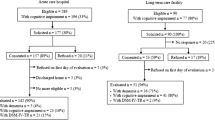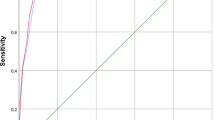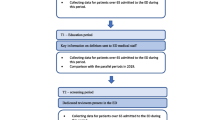Abstract
Detecting delirium in elderly emergency patients is critical to their outcome. The Nursing Delirium Screening Scale (Nu-DESC) is a short, feasible instrument that allows nurses to systematically screen for delirium. This is the first study to validate the Nu-DESC in a German emergency department (ED). The Nu-DESC was implemented in a high-volume, interdisciplinary German ED. A consecutively recruited sample of medical patients aged ≥ 70 years was screened by assigned nurses who performed the Nu-DESC as part of their daily work routine. The results were compared to a criterion standard diagnosis of delirium. According to the criterion standard diagnosis, delirium was present in 47 (14.9%) out of the 315 patients enrolled. The Nu-DESC shows a good specificity level of 91.0% (95% CI 87.0–94.2), but a moderate sensitivity level of 66.0% (95% CI 50.7–79.1). Positive and negative likelihood ratios are 7.37 (95% CI 4.77–11.36) and 0.37 (95% CI 0.25–0.56), respectively. In an exploratory analysis, we find that operationalizing the Nu-DESC item “disorientation” by specifically asking patients to state the day of the week and the name of the hospital unit would raise Nu-DESC sensitivity to 77.8%, with a specificity of 84.6% (positive and negative likelihood ratio of 5.05 and 0.26, respectively). The Nu-DESC shows good specificity but moderate sensitivity when performed by nurses during their daily work in a German ED. We have developed a modified Nu-DESC version, resulting in markedly enhanced sensitivity while maintaining a satisfactory level of specificity.

Similar content being viewed by others
References
American Psychiatric Association (2013) Diagnostic and statistical manual of mental disorders, 5th edn. American Psychiatric Association, Arlington
Han JH, Wilber ST (2013) Altered mental status in older patients in the emergency department. Clin Geriatr Med 29(1):101–136. https://doi.org/10.1016/j.cger.2012.09.005
Singler K, Thiem U, Christ M et al (2014) Aspects and assessment of delirium in old age. First data from a German interdisciplinary emergency department. Z Gerontol Geriatr 47(8):680–685
Inouye SK, Westendorp RGJ, Saczynski JS (2014) Delirium in elderly people. Lancet 383(9920):911–922. https://doi.org/10.1016/S0140-6736(13)60688-1
Barron EA, Holmes J (2013) Delirium within the emergency care setting, occurrence and detection: a systematic review. Emerg Med J 30(4):263–268. https://doi.org/10.1136/emermed-2011-200586
Han JH, Zimmerman EE, Cutler N et al (2009) Delirium in older emergency department patients: recognition, risk factors, and psychomotor subtypes. Acad Emerg Med 16(3):193–200. https://doi.org/10.1111/j.1553-2712.2008.00339.x
Meagher D (2009) Motor subtypes of delirium: past, present and future. Int Rev Psychiatry 21(1):59–73. https://doi.org/10.1080/09540260802675460
Kennedy M, Enander RA, Tadiri SP et al (2014) Delirium risk prediction, healthcare use and mortality of elderly adults in the emergency department. J Am Geriatr Soc 62(3):462–469. https://doi.org/10.1111/jgs.12692
Hustey FM, Meldon SW, Smith MD et al (2003) The effect of mental status screening on the care of elderly emergency department patients. Ann Emerg Med 41(5):678–684. https://doi.org/10.1067/mem.2003.152
Park JM, Stern TA (2010) Delirious patients. In: Stern TA, Fricchione GL, Cassem Ned (eds) Massachusetts General Hospital handbook of general hospital psychiatry, 6th edn. Elsevier/Saunders, Philadelphia, pp 93–104
Gaudreau J-D, Gagnon P, Harel F et al (2005) Fast, systematic, and continuous delirium assessment in hospitalized patients: the nursing delirium screening scale. J Pain Symptom Manag 29(4):368–375
Han JH, Wilson A, Ely EW (2010) Delirium in the older emergency department patient: a quiet epidemic. Emerg Med Clin North Am 28(3):611–631. https://doi.org/10.1016/j.emc.2010.03.005
Radtke FM, Franck M, Schust S et al (2010) A comparison of three scores to screen for delirium on the surgical ward. World J Surg 34(3):487–494. https://doi.org/10.1007/s00268-009-0376-9
Lütz A, Radtke FM, Franck M et al (2008) Die Nursing Delirium Screening Scale (Nu-DESC)—Richtlinienkonforme Übersetzung für den deutschsprachigen Raum (The Nursing Delirium Screening Scale (NU-DESC)). Anasthesiol Intensivmed Notfallmed Schmerzther 43(2):98–102. https://doi.org/10.1055/s-2008-1060551
Luetz A, Heymann A, Radtke FM et al (2010) Different assessment tools for intensive care unit delirium: which score to use? Crit Care Med 38(2):409–418. https://doi.org/10.1097/CCM.0b013e3181cabb42
Cohen JF, Korevaar DA, Altman DG et al (2016) STARD 2015 guidelines for reporting diagnostic accuracy studies: explanation and elaboration. BMJ Open 6(11):e012799. https://doi.org/10.1136/bmjopen-2016-012799
Baten V, Busch H-J, Busche C et al (2018) Validation of the brief confusion assessment method for screening delirium in elderly medical patients in a German emergency department. Acad Emerg Med. https://doi.org/10.1111/acem.13449
Han JH, Wilson A, Vasilevskis EE et al (2013) Diagnosing delirium in older emergency department patients: validity and reliability of the delirium triage screen and the brief confusion assessment method. Ann Emerg Med 62(5):457–465. https://doi.org/10.1016/j.annemergmed.2013.05.003
Busse A, Sonntag A, Bischkopf J et al (2002) Adaptation of dementia screening for vision-impaired older persons: administration of the Mini-Mental State Examination (MMSE). J Clin Epidemiol 55(9):909–915
Gilboy N, Tanabe T, Travers D et al (2011) Emergency Severity Index (ESI): A triage tool for emergency department care, version 4. Implementation handbook 2012 edition. AHRQ Publication, 12-0014. Agency for Healthcare Research and Quality, Rockville
Knaus WA, Draper Elizabeth A, Wagner Douglas P, Zimmerman JE (1985) APACHE II: a severity of disease classification system. Crit Care Med 13(10):818–829
Landis JR, Koch GG (1977) The measurement of observer agreement for categorical data. Biometrics 33(1):159–174
Lingehall HC, Smulter N, Engström KG et al (2013) Validation of the Swedish version of the Nursing Delirium Screening Scale used in patients 70 years and older undergoing cardiac surgery. J Clin Nurs 22(19–20):2858–2866. https://doi.org/10.1111/j.1365-2702.2012.04102.x
Hargrave A, Bastiaens J, Bourgeois JA et al (2017) Validation of a nurse-based delirium-screening tool for hospitalized patients. Psychosomatics 58(6):594–603. https://doi.org/10.1016/j.psym.2017.05.005
Poikajärvi S, Salanterä S, Katajisto J et al (2017) Validation of Finnish Neecham Confusion Scale and Nursing Delirium Screening Scale using confusion assessment method algorithm as a comparison scale. BMC Nurs 16:7. https://doi.org/10.1186/s12912-016-0199-6
Tamune H, Yasugi D (2017) How can we identify patients with delirium in the emergency department? A review of available screening and diagnostic tools. Am J Emerg Med 35(9):1332–1334. https://doi.org/10.1016/j.ajem.2017.05.026
Han JH, Wilson A, Graves AJ et al (2014) Validation of the confusion assessment method for the intensive care unit in older emergency department patients. Acad Emerg Med 21(2):180–187. https://doi.org/10.1111/acem.12309
Han JH, Vasilevskis EE, Schnelle JF et al (2015) The diagnostic performance of the Richmond Agitation Sedation Scale for detecting delirium in older emergency department patients. Acad Emerg Med 22(7):878–882. https://doi.org/10.1111/acem.12706
O’Sullivan D, Brady N, Manning E et al (2018) Validation of the 6-Item Cognitive Impairment Test and the 4AT test for combined delirium and dementia screening in older Emergency Department attendees. Age Ageing 47(1):61–68. https://doi.org/10.1093/ageing/afx149
Grossmann FF, Hasemann W, Kressig RW et al (2017) Performance of the modified Richmond Agitation Sedation Scale in identifying delirium in older ED patients. Am J Emerg Med 35(9):1324–1326. https://doi.org/10.1016/j.ajem.2017.05.025
Hasemann W, Grossmann FF, Stadler R (2017) Screening and detection of delirium in older ED patients: performance of the modified confusion assessment method for the Emergency Department (mCAM-ED). A two-step tool. Intern Emerg Med. https://doi.org/10.1007/s11739-017-1781-y
Kohn MA, Carpenter CR, Newman TB (2013) Understanding the direction of bias in studies of diagnostic test accuracy. Acad Emerg Med 20(11):1194–1206. https://doi.org/10.1111/acem.12255
Acknowledgements
We thank all the Emergency Department nurses at the University Hospital of Freiburg who performed the Nu-DESC. We also thank Susanne Weber, MSc, (Institute of Medical Biometry and Statistics, Medical Faculty and Medical Center, University of Freiburg) for advice on the data analysis.
Data availability
The datasets generated during and analyzed during the current study are available from the corresponding author on reasonable request.
Author information
Authors and Affiliations
Corresponding author
Ethics declarations
Conflict of interest
The authors declare that they have no conflict of interest.
Research involving human and/or animal participants
The study was approved by the Local Ethics Committee (No. 72/16). All procedures performed in studies involving human participants were in accordance with the ethical standards of the institutional or national research committee and with the 1964 Helsinki declaration and its later amendments or comparable ethical standards.
Informed consent
If possible, oral informed consent was obtained directly from the patient or an authorized proxy. According to our local ethics committee written or verbal consent from the patients was not required as this was an evaluation-based study aiming for permanent implementation of the Nu-DESC for delirium screening in the ED. In order to ensure the best treatment for all patients, EPs were informed about the criterion standard diagnosis subsequent to the completion of all tests.
Electronic supplementary material
Below is the link to the electronic supplementary material.
Rights and permissions
About this article
Cite this article
Brich, J., Baten, V., Wußmann, J. et al. Detecting delirium in elderly medical emergency patients: validation and subsequent modification of the German Nursing Delirium Screening Scale. Intern Emerg Med 14, 767–776 (2019). https://doi.org/10.1007/s11739-018-1989-5
Received:
Accepted:
Published:
Issue Date:
DOI: https://doi.org/10.1007/s11739-018-1989-5




